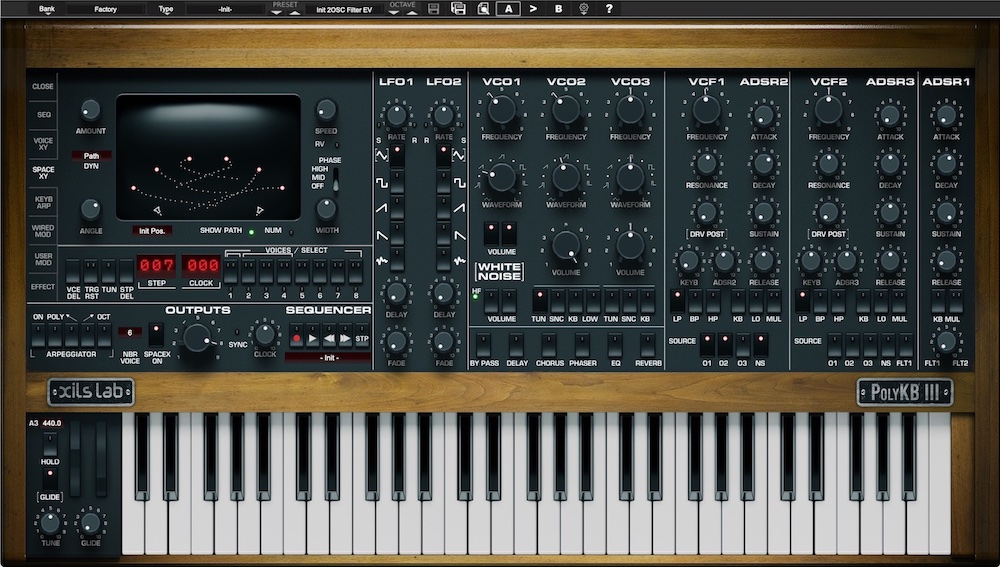XILS-Lab deserves its reputation as one of the best software synth makers in the industry. They remain a favorite of TabMuse, as evidenced by our previous reviews of XILS 4, PolyM, KaoX, and XILS 505. The XILS team’s analog synth plugin, PolyKB III, provides another winner, with a top-shelf emulation of the legendary RSF PolyKobol 2 analog polysynth.
PolyKB III offers users a straightforward architecture, especially for those boasting a strong comfort level with subtractive synthesis. Still, that same concise design also makes it easy for new synthheads to grasp. Of course, the plugin’s sonics are killer, featuring the analog character and sense of chaos typical of other XILS plugins.
PolyKB III Features
- Three Morphing Oscillators
- Two Multimode Filters
- Three ADSR Envelopes
- Two LFOs
- Polyphonic Step Sequencer
- Flexible Arpeggiator
- Four Robust Modulation Matrixes
- Including Unique X-Y Voice and Space Matrixes
- That Bespoke XILS-Lab Analog Character
- Available for 199 Euros
Let’s dive into the details of the PolyKB III, its architecture, UI, and sonics. We enjoyed exploring its simple, yet powerful, synth design. The robust modulation possibilities, including the cool X-Y Voice and Space modules, provide many intriguing options for creative sound designers.
Here’s a quick piece by Church of Hed, exploring four different PolyKB III patches in an electronic ditty with a pretentious title, PolyKB III Synth Quartet No.1. The four parts serve as a bass line, a pad, a lead, and synth effects.
PolyKB III Features an Intuitive User Interface
Like other XILS-Lab synth plugins, PolyKB III sports a skeuomorphic user interface design based on the original hardware synth. Of course, other UI features also match other XILS-Lab designs, including the main toolbar primarily used for preset management. Expect easy access to the plugin’s settings and help documentation also on this toolbar.

This review focuses on the meat of the PolyKB III UI and its emulation of the original PolyKobol 2. The straightforward design of the synth architecture results in a plugin easily accessible to anyone familiar with subtractive synthesis. The main interface window provides access to all the modules of the synth, including oscillators, LFOs, filters, and envelopes.
A section to the left of these synth modules offers playback support for the arpeggiator, sequencer, and volume control. Above this functionality lies a tabbed area with access to more detailed functionality. This includes sections for editing sequences and arpeggiations, the modulation matrixes, effects, and the unique Voice XY and Space XY mod matrixes. We cover those later in this review.
A virtual keyboard with pitch and modulation wheels along with tuning, hold, and glide support round out this synth plugin’s UI. All told, PolyKB III’s user interface makes it easy to dive right into designing bespoke patches or tweaking the robust collection of factory presets.
Exploring the PolyKB III Synth Modules
The original PolyKobol 2’s variable waveform oscillators served as a calling card to synth freaks in the 80s. Of course, this feature remains commonplace in modern hardware synth design, like in our beloved Moog Sub 37. The PolyKB III’s oscillator modules emulate these real-time variable waveforms, making them attractive destinations in the plugin’s robust modulation functionality.
The PolyKB III oscillator module features three oscillators, each with a waveform varying from a triangle to a narrow pulse wave. It provides the ability to hard sync oscillator 1 to oscillators 2 and 3. The second oscillator also functions as an LFO by clicking the LOW switch. Access the white noise source from within this module to add a measure of grunge or grit to your patches. Note that each oscillator includes either a volume knob or switches in lieu of a separate mixer module.
The two 4-pole filter modules operate in high-pass, low-pass, or bandpass mode, each with its own ADSR envelope. A mixer knob at the bottom of the volume envelope controls the relative level of the two filters. Each filter includes an array of source switches with inputs from the three oscillators and the white noise. The second filter also takes the output of the first as an input.
Not surprisingly, cranking the resonance sends either filter into self-oscillating mode. It sounds great, adding bite to any classic synth sound. Note that both filters still self-oscillate without any input signal from the oscillators. Each filter module has other knobs controlling how much the keyboard follow and envelope settings modulate the filter’s cutoff frequency.
Three ADSR envelope modules all sport the typical knobs for controlling, attack, decay, sustain, and release. The two filter envelopes also include a LO switch for looping. The KB switch turns the keyboard follow functionality on or off. The dual MUL switch increases the length of the four envelope parameters by a factor of 2 to 4, suitable for creating pads or drones.
The PolyKB III synth architecture also boasts two dedicated LFOs. Of course, these serve as great modulation sources. A collection of switches controls the shape of each LFO’s waveform. One cool feature provided by PolyKB III involves selecting multiple waveforms simultaneously to create complex shapes to be used for modulation. This feature warrants a deeper dive for sound designers.
Each LFO has a Rate knob including a switch for syncing to the clock of your DAW application. They also include Delay and Fade knobs providing a contour for the impact of each LFO’s modulation. When combined with the ability to combine waveforms, the LFOs offer a unique capability to create synth patches with a strange and evolving sense of motion.
Perusing the Rest of the PolyKB III Interface and Architecture
Let’s explore the rest of the PolyKB III UI and synth architecture. As noted earlier, the plugin features four separate mod matrixes, accessible within the tabbed section on the left side of the interface. In the Wired Mod tab, one matrix features hardwired sources and destinations, emulating the original PolyKobol modulation support.
The sources for this first matrix include LFO 1, LFO 2/Noise, ADSR 2, VCO 2, and pressure/velocity. Expect a standard array of destinations: the pitch and waveform of the three VCOs and the cutoff frequency for the two filters. Remember, those continuously variable waveforms were the “feature of note” for the original PolyKobol.
Note each source’s knob for controlling the modulation level, while the Wheel switch also lets a mod wheel join in on the fun. Additionally, each destination allows switching between positive and negative modulation. The pressure and velocity mod source provides the ability to control Envelope 1’s attack and decay, the VCA, and the VCF cutoff frequency.
A double-barreled 2X4 modulation matrix inside the User Mod tab allows synth heads a choice of both sources and destinations. The two sources each include their own Amount knob controlling the level of modulation. The four destinations all allow both positive and negative modulation. These user assignable matrixes let sound designers fill in any gaps not provided by the hard-wired matrix.
The Voice XY matrix supports a graphical X-Y display approach to modulation. The sources are hardwired, with the number of modulation points based on whether a synth path is in Unison or Polyphonic mode. Obviously, the latter creates more points. The synth programmer draws paths from the existing points in the display to modulate the chosen destination: the same options as the User Mod matrix.
Note the Space XY tab includes the fourth mod matrix, with a similar X-Y approach to the stereo panning of voices within a synth patch. These last two mod matrixes combine to provide sound designers with the means to create classic subtractive synth patches with a modern sheen. Both are powerful tools to add a measure of movement to any PolyKB III sound, especially those using multiple voices.
PolyKB III also features a powerful sequencer and arpeggiator, accessible in separate tabs, with their live performance controls lurking underneath the tab panel. The arpeggiator’s simplicity belies its power, considering the ability to build chord progressions into any arpeggiation. The polyphonic sequencer provides the ability to generate complex sequences – one for each voice – as well as serving as a useful modulation source.
Finally, PolyKB III includes an effects engine with a typical array of effectery: delay, phaser, chorus, reverb, and EQ. Expect to be familiar with the controls for each; many of which are also modulation destinations. All told, they provide a great way to finalize a synth patch design.
A Synth Plugin with a True Sense of Character
Typical of the other XILS-Lab synths reviewed at TabMuse, PolyKB III provides a real sense of character. Within a mix, it fits nicely side by side with my hardware synths – both analog and digital. The Drift knob provides an example of this XILS approach. It emulates variations between individual synth voices based on the subtle differences in the hardware components.
This synth plugin supports the wide array of sonic possibilities typical of subtractive synthesis, but takes things further with its robust modulation architecture, especially the Voice XY and Space XY matrixes. Check out the PolyKB III Synth Quartet No. 1 (a sufficiently pretentious title!) video posted earlier for an example of this sonic range.
Like the other XILS-Lab synths we reviewed, we give PolyKB III our highest recommendation. Considering the stunted historical legacy of the original PolyKobol, it heartens one to see a plugin inspired by it to make a real impact in the modern world of synth design. Check it out today!
